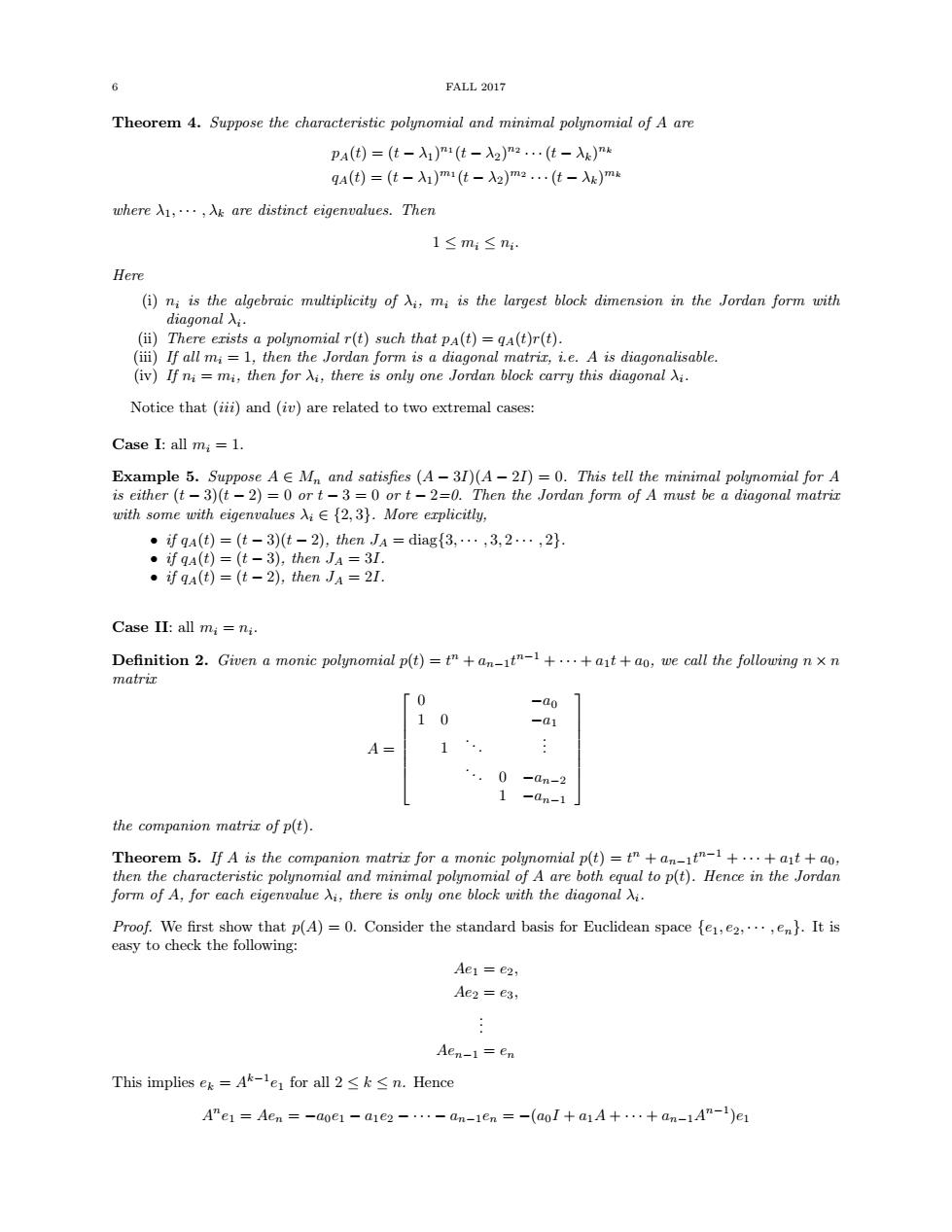正在加载图片...

6 FALL 2017 Theorem 4.Suppose the characteristic polynomial and minimal polymomial of A are pA()=(t-)(t-2)…t-A) ga(t)=(t-A1)mi(t-X2)m2...(tk)m here入L,..,入are distinct eigenvalues.Then 1≤m≤n Here (i)n is the algebraic multiplicity of m is the largest block dimension in the Jordan form with (ch)( rir.ie.A is diagonalisable (iv)if n=mi,then fori there is only one Jordan block carry this diagonal Notice that (iii)and (iv)are related to two extremal cases: Case I:all mi=1. ith some with =-3t-2,到then JA=diag{8…,3,2…,2 Case IⅡ:allm=n Definition 2.Given a monic polynomial p(t)=+++t+o we call the following n xn matri证 「0 “. 1二- the companion matriz of p(t). Theorem 5.If A is the companion matriz for a monic polynomial p(t)=t"+an-t"-+..+at+ao then the characteristic polynomial and minimal polynomial of A are both equal to p(t).Hence in the Jordan form of A,for each eigenvalue Ai:there is only one block with the diagonal Ai. easy to check the Ae1=e2, Ae2 e3: Aen-1=en This implies-Ak-le1 for all2≤k≤n.Hence A"e1 Aen =-aoel-are2 -...an-1en =-(aoI+aA+...+an-1A"-!)e16 FALL 2017 Theorem 4. Suppose the characteristic polynomial and minimal polynomial of A are pA(t) = (t − λ1) n1 (t − λ2) n2 · · ·(t − λk) nk qA(t) = (t − λ1) m1 (t − λ2) m2 · · ·(t − λk) mk where λ1, · · · , λk are distinct eigenvalues. Then 1 ≤ mi ≤ ni . Here (i) ni is the algebraic multiplicity of λi, mi is the largest block dimension in the Jordan form with diagonal λi. (ii) There exists a polynomial r(t) such that pA(t) = qA(t)r(t). (iii) If all mi = 1, then the Jordan form is a diagonal matrix, i.e. A is diagonalisable. (iv) If ni = mi, then for λi, there is only one Jordan block carry this diagonal λi. Notice that (iii) and (iv) are related to two extremal cases: Case I: all mi = 1. Example 5. Suppose A ∈ Mn and satisfies (A − 3I)(A − 2I) = 0. This tell the minimal polynomial for A is either (t − 3)(t − 2) = 0 or t − 3 = 0 or t − 2=0. Then the Jordan form of A must be a diagonal matrix with some with eigenvalues λi ∈ {2, 3}. More explicitly, • if qA(t) = (t − 3)(t − 2), then JA = diag{3, · · · , 3, 2 · · · , 2}. • if qA(t) = (t − 3), then JA = 3I. • if qA(t) = (t − 2), then JA = 2I. Case II: all mi = ni . Definition 2. Given a monic polynomial p(t) = t n + an−1t n−1 + · · · + a1t + a0, we call the following n × n matrix A = 0 −a0 1 0 −a1 1 . . . . . . . . . 0 −an−2 1 −an−1 the companion matrix of p(t). Theorem 5. If A is the companion matrix for a monic polynomial p(t) = t n + an−1t n−1 + · · · + a1t + a0, then the characteristic polynomial and minimal polynomial of A are both equal to p(t). Hence in the Jordan form of A, for each eigenvalue λi, there is only one block with the diagonal λi. Proof. We first show that p(A) = 0. Consider the standard basis for Euclidean space {e1, e2, · · · , en}. It is easy to check the following: Ae1 = e2, Ae2 = e3, . . . Aen−1 = en This implies ek = Ak−1 e1 for all 2 ≤ k ≤ n. Hence A n e1 = Aen = −a0e1 − a1e2 − · · · − an−1en = −(a0I + a1A + · · · + an−1A n−1 )e1